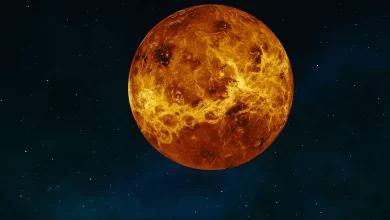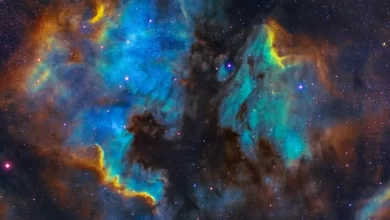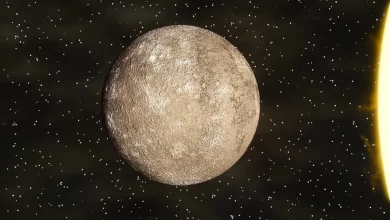The Milky Way is named after the milky, white band of stars visible from Earth that spans the celestial sphere. The galaxy is thought to contain between 200 and 400 billion stars. The Milky Way is one of the biggest galaxies in the universe, with a diameter of about 300,000 light-years.
- The wind coming from the center of the Milky Ways traveling at two million mph.
- According to a new study, our Milky Way galaxy is home to at least 100 billion alien planets and stars and possibly many more.
- A cosmic year is the time it takes the sun to revolve around the center of the Milky Way (between 225-250 million years).
- Our nearest major galactic neighbor is the Andromeda Galaxy which is 2.5 million light-years away and contains up to one trillion suns. It is heading towards the milky way at a speed of 313,200 miles per hour when it will eventually collide with our Milky Way Galaxy.
- The Milky Way and Andromeda galaxy are on a collision course in about 3 billion years.
- The Andromeda galaxy is the only galaxy outside the Milky Way visible to the naked eye.
- In the core of the starburst galaxy, M82 or the Cigar Galaxy stars, birth goes on at a rate ten times faster than the entire Milky Way Galaxy.
- The fastest star-making machine in the known universe is a starburst galaxy 12.3 billion light-years distant nicknamed Baby Boom. It produces around 4,000 stars per year, compared to the Milky Way’s ten stars a year.
- PSR J1748-2446ad is the fastest spinning known pulsar; it is less than 16km across and is under twice the mass of the sun. It is spinning at 70,000 km per second at its equator, which is 24% the speed of light.
- All of the stars that comprise the Milky Way galaxy revolve around the center of the galaxy once every 200 million years or so.
- There is a group of 30 galaxies known as the local group. The Milky Way also belongs to this cluster. This whole cluster is 7 million light-years across.
- The Milky Way galaxy looks the brightest when viewed in the direction of the constellation of Sagittarius, towards the center of the galaxy.
- The Milky Way, as a spiral galaxy, moves at a speed of 130 miles per second and is so vast and big that even at this speed, it takes 225 million years to do one complete orbit.
- There are about 230 known Wolf-Rayet stars in the Milky Way, with another 100 in the Large Magellanic Cloud and 12 in the Small Magellanic Cloud.
- Dark matter is believed to be present within and all around the Milky Way galaxy in the form of a halo.
- The Milky Way is only one of the billions of other galaxies in the observable universe.
- The Milky Way galaxy is about 13.51 billion years old, almost as old as the universe itself.
- The Milky Way galaxy is huge and has a radius of about 50,000 light-years.
- The Milky Way galaxy has a mass of 1.5 trillion suns
- As the solar system travels through the galaxy, it does not stay level but bobs up and down along the plane of the Milky Way. This up and down motion has been noticed to coincide with major extinction events.
- Milky Way is a spiral galaxy that consists of a flat disk with a bulging center and surrounding spiral arms. The galaxy’s disk includes planets, stars, dust, and gas, all of which rotate around the galactic center in a regular manner.
- If you look up at the stars with your naked eyes on a clear night, you will only ever see 0.000003 % of the number that make up the Milky Way.
- The Milky Way galaxy is mostly composed of dark matter, which is basically a hypothetical matter that has its main characteristic is not being reactive towards electromagnetic force.
- If you could squeeze all the stars in the Milky Way together into a single mass, it would fit into the volume of space between our sun to the nearest star.
- Our sun and the surrounding planets orbit around the center of the Milky Way galaxy once every 250 million years, which is also known as the galactic year.
- The Cat’s Paw Nebula is a vast stellar nursery near the heart of the Milky Way, 50 light-years across. It is one of the most active star birth regions in our galaxy and really does look like a cat‘s paw print in space.
- The Milky Way got its name from Greek mythology. The goddess Hera who sprayed milk across the sky. In other parts of the world, our galaxy is called by other names. In China, it’s called the “Silver River,” and in the Kalahari Desert in Southern Africa, it’s called the “Backbone of Night.
- Galaxies are sprawling space systems composed of dust, gas, and countless stars. The number of galaxies cannot be counted; the observable universe alone may contain 100 billion galaxies. Some of these distant systems are similar to our own Milky Way galaxy, while others are quite different.
- Astronomers believe that space is not a complete vacuum; there are three atoms per cubic meter.
- If the Milky Way Galaxy was reduced to 10 meters in diameter, the entire solar system, including its furthest outer reaches, would be no bigger than 0.1 of a millimeter across.
- Pulsars probably result from a supernova explosion – that is why most are found in the flat disc of the Milky Way, where supernovae occur.
- The solar system is traveling through an interstellar cloud in the Milky Way that is 30 light-years wide; astronomers call this cloud the Local Fluff. The solar system entered it between 44,000 and 150,000 years ago, and it will take us another 10,000 to 20,000 years to pass through it.
- If we imagine that you were able to hold the Milky Way galaxy in your hand, the nearest galaxy to you would be a walk of about three months away.
- The astronomers believe that supernova explosion occurs approximately twice every 100 years in our galaxy. This means that supernova explosions are relatively rare events within our Milky Way galaxy. Most galaxies have a supernova every 25 to 100 years.
- Since our solar system was formed, it has only done 20 orbits of the Milky Way Galaxy so far.
- Earth orbits the sun at an average distance of about 150 million kilometers and about bout 28,000 light-years from the center of the Milky Way galaxy.
- Planets move within the Solar System, which moves within the Milky Way Galaxy, which moves within The Local Group of Galaxies, which moves towards Virgo Cluster.
- The next nearest star to us (other than the sun) is Proxima Centauri, in the Alpha Centauri star system (still part of our Milky Way galaxy), which is about 40 trillion (40,000,000,000,000) miles away or, using the more convenient unit based on the distance light travels in a year (which is about 9.46 trillion kilometers), 4.24 light-years. Sirius A and B, in the Sirius star system, are about 81 trillion (81,000,000,000,000) kilometers or 8.58 light-years away.
- The Milky Way has more than 200 moons. Only Jupiter has about 52 moons.





